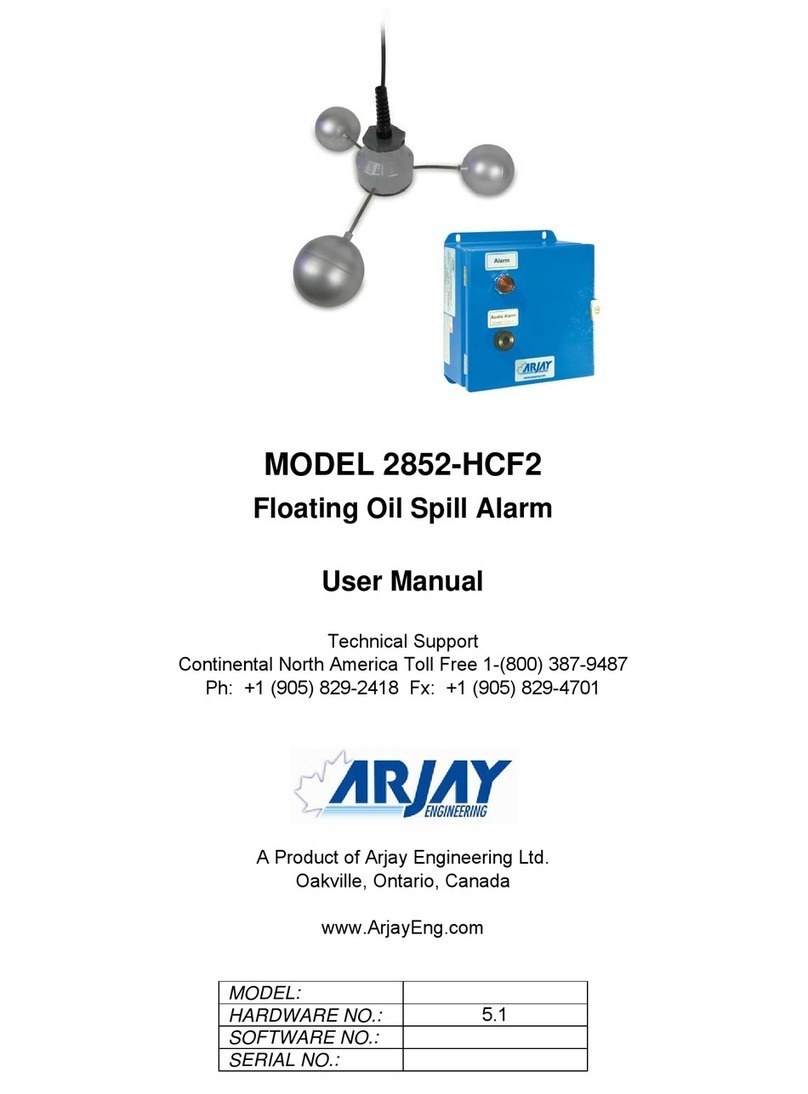
Arjay Engineering Ltd. 2851 Br ghton Road Oakv lle, Ontar o Canada L6H 6C9
http://www.arjayeng.com telephone: ++1 905-829-2418 N. Amer ca toll free: 1-800-387-9487 fax: ++1 905-829-4701
2852-LPS-12b
• sensor pads can be placed in key locations
and tight spaces
• up to 3 sensor pads can connect to one
control unit
• adjustable time delay and sensitivity to
eliminate nuisance alarms
• remote electronics via standard twisted pair
• sensor available Intrinsically Safe for
Hazardous Locations
• high grade epoxy and PVC wetted parts
allow for corrosive environments
• capacitance technology responds to all
types of liquids
Technical Specifications - Control Unit
perating Temp. -20˚C to +55˚C
Resolution .007% (.07 pF at 1,000 pF)
Accuracy .04% of full scale pF
Power Input 12 vdc or 24 vdc or 100-240 vac +/-10%
Alarm Relay 2 x 10 amp@240 vac, SPDT, dry
Analog utput 4 mA normal/20 mA alarm
Communication Modbus RS-485
Certified UL 61010-1, 2ndEdition
CAN/CSA-22.2 61010-1-4
IEC/EN 61010-1, 2ndEdition
IEC 61326-1
CE Declared
Enclosure Type 4 / IP 66 painted steel
or Type 4X / IP 66 polycarbonate or SS
ptional Light, buzzer, beacon
Technical Specifications - Sensing Pads
perating Temp. -60˚C to +55˚C
Intrinsic Safety CSA Intrinsically Safe when ordered with
Approved Barrier in Control Unit
Div 1, Class I, Groups A,B,C,D;
Class II, Groups E,F,G;
Class III, Encl. Type 4
Wetted Parts High grade marine epoxy and PVC
(optional PVDF/TFE).
Sensor materials are eligible for NACE MR-0175 Compliance
2852-LPS
Feat res and Benefits
The unique PMC circuit design, installed at the probe and
exclusive to Arjay, immediately converts the sensor signal to
a frequency pulse for furtherance to the controller.
Alarm and Status LCD display of alarm
status and menus
RS-485 Modbus user interface
4 mA normal/20 mA alarm output
Probe
input
Power
input
Relays
up to 1 km




























